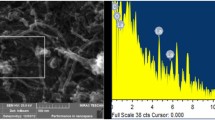Abstract
Attenuators are used to suppress the reflections in the helix traveling wave tubes and these attenuators are normally fabricated with the coating of some lossy material on the helix support rods. Carbon is the most commonly used attenuator material for the microwave applications and is usually deposited by pyrolytic or sputtering methods. However, other materials like iron and nickel are also used sometime for the attenuation applications. Helix is usually supported by the rods of some ceramic material like APBN (Anisotropic Pyrolytically Deposited Boron Nitride) or Alumina etc. Attenuator materials are deposited on these support rods to absorb the reflections. In order to look forward to new methods of deposition as well new attenuator materials, Carbon nanotubes have been proposed as another alternative attenuator material. Multi-Wall Cabon Nano-Tubes have been grown on the rectangular alumina substrate using the chemical vapour deposition method. Microwave attenuation/loss has been measured on these samples with X-band microwave frequencies. Specific experimental set-up has been designed for the measurement. The work is centered toward making good quality novel attenuators for the microwave applications and particularly the TWT.





Similar content being viewed by others
References
V. Kesari, B.N. Basu, Analysis of some periodic structures of microwave tubes: part I: analysis of helical slow-wave structures of traveling-wave tubes. J. Electromag. Waves Appl. 31(1), 1–37 (2017). https://doi.org/10.1080/09205071.2016.1276862
A. Ishimaru, Electromagnetic Wave Propagation, Radiation, and Scattering: from Fundamentals to Applications (Wiley, Hoboken, NJ, 2017)
J. Copeland, A.A. Haef, Andrei Haeff and the Amazing Microwave Amplifier, in IEEE Spectrum (September, 2015), pp.32–37
K.V. Rao, T. Chanakya, V.B. Naidu, S.K. Datta, Investigation into a triangular-helix slow-wave structure, in Proceedings of IEEE Vacuum Electronics Conference, (2014), pp. 293–294. https://doi.org/10.1109/IVEC.2014.6857605
D. Ge, B. Hu, Methods to improve the phase stability of high-power TWTA. Proc. IEEE Int. Conf. Microw. Millim. Wave Technol. (ICMMT) 1, 150–152 (2016). https://doi.org/10.1109/ICMMT.2016.7761706
D.M. Goebel, J.G. Keller, W.L. Menninger, S.T. Blunk, Gain stability of travelling wave tubes. IEEE Trans. Electr. Dev. 46(11), 2235–2244 (1999). https://doi.org/10.1109/16.796301
V. Srivastava, Nonlinear analysis of beam-wave interaction in a planar THz travelling-wave tube amplifier. J. Electromag. Waves Appl. 32(2), 190–203 (2018). https://doi.org/10.1080/09205071.2017.1374217
J.F. Gittins, Power Travelling Wave Tubes (Elsevier, New York, 1965)
V. Kumar, A. Vohra, V. Srivastava, Experimental evaluation of lossy coatings of different materials on helix support rods for a high efficiency TWT, in Proceedings of IEEE International Conference on Microwave and Telecommunication Technology, (September 13–17, 2004), pp. 648–650. https://doi.org/10.1109/CRMICO.2004.183377
V. Srivastava, T.K. Ghosh, M.J. Akhtar, S.N. Joshi, Design of high efficiency space TWT. IETE Tech. Rev. 16(2), 249–254. https://doi.org/10.1080/02564602.1999.11416837
P. Nikolaev, M.J. Bronikowski, et al., Gas phase catalytic growth of single walled carbon nano tubes from carbon moxide. Chem. Phys. Lett. 313, 91–97 (1999). https://doi.org/10.1016/S0009-2614(99)01029-5
A.M. Casel et al., Large Scale CVD synthesis of single walled carbon nanotubes. J. Phys. Chem. B 103, 6484–6492 (1999). https://doi.org/10.1021/jp990957s
M. Kumar, Y. Ando, Chemical vapor deposition of carbon nanotubes: a review on growth mechanism and mass production. J. Nanosci. Nanotechnol. 10(6), 3739–3758 (2010)
V. Kumar, A. Vohra, V. Srivastava, Nickel and iron as attenuator materials for helix TWT. Indian J. Radio Space Phys. 36(4), 345–347 (2007) http://hdl.handle.net/123456789/2885
V. Kumar, A. Vohra, V. Srivastava, Characterisation of carbon attenuator coatings for helix TWT applications. New Carbon Mater. 23(4), 378–381 (2008). https://doi.org/10.1016/S1872-5805(09)60008-1
T. Chiu, Dielectric constant measurement technique for a dielectric strip using a rectangular waveguide. IEEE Trans. Instrument. Measure. 52(5), 1501–1508 (2003). https://doi.org/10.1109/TIM.2003.817904
Author information
Authors and Affiliations
Corresponding author
Additional information
Publisher’s Note
Springer Nature remains neutral with regard to jurisdictional claims in published maps and institutional affiliations.
Rights and permissions
About this article
Cite this article
Kumar, V. Carbon Nano Tubes: Synthesis and Characterization for Microwave Applications. Trans. Electr. Electron. Mater. 22, 515–518 (2021). https://doi.org/10.1007/s42341-020-00260-6
Received:
Revised:
Accepted:
Published:
Issue Date:
DOI: https://doi.org/10.1007/s42341-020-00260-6




